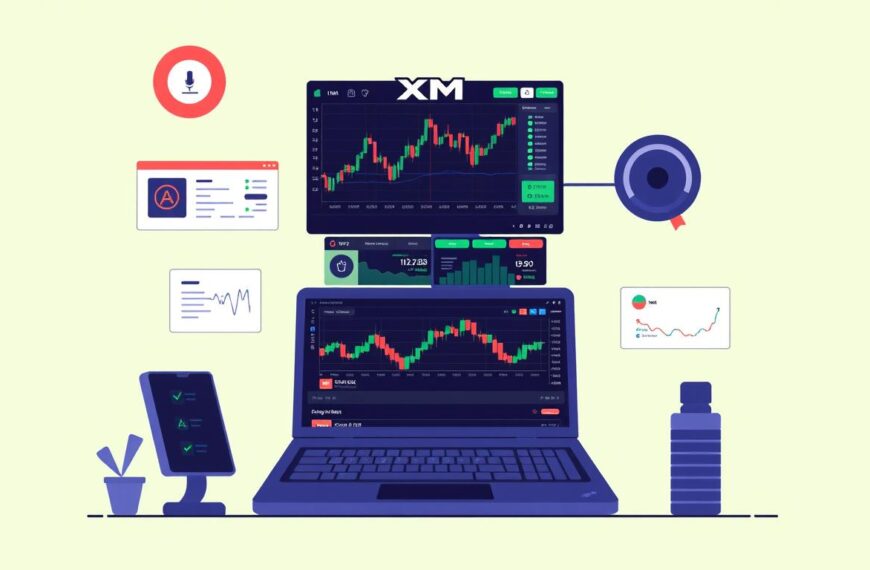The recent surge in trade tensions has left many investors reeling, but one trader turned this chaos into a lucrative opportunity, raking in a $30,000 profit. The unpredictable nature of markets during times of economic uncertainty can be daunting, yet it also presents unique chances for growth.
As tariffs are imposed and trade wars escalate, the economy is affected in far-reaching ways. Savvy traders who understand how to navigate these turbulent waters can capitalize on the volatility. By examining the dynamics of global trade and its impact on the market, traders can identify profitable opportunities.
Key Takeaways
- Trade tensions can create market volatility that savvy traders can exploit for profit.
- Understanding the impact of tariffs on the economy is crucial for making informed trading decisions.
- Strategic market positioning is key to capitalizing on trade war dynamics.
- Market inefficiencies during trade wars can be identified through a combination of macroeconomic analysis and technical trading strategies.
- Traders who adapt quickly to changing trade policies can secure significant profits.
Understanding Trade Wars and Market Volatility
In the complex world of international trade, understanding the impact of trade wars on market volatility is crucial. Trade wars are typically a manifestation of protectionism, where governments implement policies to restrict international trade, shielding domestic businesses and jobs from foreign competition.
Defining Trade Wars in Global Markets
A trade war occurs when countries impose retaliatory measures against each other’s imports, typically through tariffs or other trade restrictions. This creates significant market disruptions and is often driven by economic conflicts between nations seeking to protect domestic industries or gain political leverage. The fundamental nature of trade wars involves a delicate balance between economic and political interests.
| Aspect | Description | Impact |
|---|---|---|
| Tariffs | Taxes imposed on imported goods | Increased cost for consumers, potential for retaliatory tariffs |
| Trade Restrictions | Limitations on the quantity or type of goods imported | Reduced trade volumes, potential for market volatility |
| Economic Conflict | Disputes between nations over trade practices | Market uncertainty, potential for significant economic impact |
How Market Volatility Creates Profit Opportunities
Market volatility during trade tensions stems from uncertainty about supply chains, production costs, and future economic relationships between major trading partners. Traders can capitalize on this volatility through various strategies, including sector rotation, options strategies, and short-term directional trades based on policy announcements. Historical data shows that markets often overreact to trade war headlines, creating pricing inefficiencies that skilled traders can exploit for substantial profits.
Understanding the economic sectors most vulnerable to trade restrictions helps traders identify both shorting opportunities and potential value investments during market corrections. By staying informed about global trade dynamics and market reactions, traders can navigate the complexities of trade wars and capitalize on emerging opportunities.
The Anatomy of the US-China Trade Conflict
The ongoing trade tensions between the US and China have their roots in a series of events that began to unfold in early 2018. At its core, the conflict is a complex interplay of economic policies, national security concerns, and technological competition between the two global superpowers.
Timeline of Escalating Tensions
The US-China trade conflict began in earnest in 2018 when President Donald Trump imposed the first round of tariffs on Chinese imports, citing unfair trade practices and intellectual property theft concerns. This move marked the beginning of a tit-for-tat escalation that has continued through multiple administrations.
By January 2018, President Trump had imposed a series of tariffs on a wide range of goods, including steel, aluminum, solar panels, and washing machines. Some of these measures impacted goods from the European Union (EU), Canada, China, and Mexico. China’s response was swift, with the country imposing retaliatory tariffs on American goods, thus initiating a cycle of escalation.
By May 2019, tariffs on Chinese imports had impacted nearly $200 billion of imports. The trade conflict continued to escalate, with the Trump administration and China engaging in a series of negotiations and tariff adjustments.
Key Tariffs and Their Market Impact
The trade conflict has seen key tariffs targeting strategic sectors, including steel, aluminum, agricultural products, and technology. By 2024, rates had reached as high as 100% on certain items. The administration of President Biden continued this trend, raising tariffs on electric vehicles to 100%, with solar cells and semiconductors facing tariffs of 50%.
Market reactions to each round of tariff announcements created significant volatility in equity markets, particularly in sectors heavily dependent on US-China trade. The trade conflict has evolved beyond simple economic policy into a broader strategic competition, with technology and national security concerns increasingly driving decisions.
Understanding this timeline and the impact of key tariffs provides traders with historical context for anticipating market reactions to new developments in the ongoing trade tensions between the United States and China.
Global Conflict Trading: Turning Chaos Into Opportunity
Global conflict trading has emerged as a lucrative strategy for those who can navigate the complexities of international tensions. When one country uses tariffs or other sanctions to damage another country’s economy, the result is often retaliation and trade war. The Trump administration is betting that because the U.S. is the world’s largest economy, China and other foreign exporters will struggle to find viable alternatives. This, in turn, would give the U.S. decisive leverage in the trade war between the two countries.
Identifying Trading Signals During International Disputes
To succeed in global conflict trading, one must adopt a systematic approach to identifying actionable signals amid the noise of international disputes and political rhetoric. Successful traders develop expertise in recognizing patterns in how markets respond to escalating tensions between major economic powers. Key trading signals include:
- Unusual volume in sector ETFs
- Widening credit spreads
- Currency volatility
- Commodity price movements that often precede broader market reactions
Risk Assessment in Conflict-Driven Markets
Risk assessment becomes particularly critical during international conflicts, as normal market correlations can break down and liquidity conditions may deteriorate rapidly. Position sizing and stop-loss discipline are essential components of conflict trading strategy, as markets can reverse direction quickly based on unexpected diplomatic developments. Traders must balance technical analysis with fundamental understanding of which companies and sectors have the greatest exposure to potential trade disruptions.
Developing a framework for evaluating the severity and potential duration of international disputes helps traders distinguish between short-term noise and longer-term structural shifts in global trade relationships. By doing so, traders can make informed decisions and capitalize on the opportunities presented by global conflicts.
Case Study: How One Trader Secured a $30K Profit
Amidst the chaos of escalating trade tensions, a savvy trader identified a lucrative opportunity that yielded $30,000. This case study follows the trader’s strategic decisions during the US-China trade conflict, highlighting the steps taken to capitalize on market volatility.
The Trade Setup: Spotting the Pattern
The trader noticed a specific pattern in manufacturing stocks following the announcement of new tariffs on Chinese imports. While the broader market reacted negatively to trade tension headlines, certain domestic manufacturers with limited exposure to Chinese supply chains showed consistent strength. This divergence presented a profitable trade opportunity.
Entry and Exit Strategy Breakdown
The trader employed a combination of options strategies and targeted equity positions to benefit from both immediate market volatility and longer-term sector rotation. The entry strategy involved scaling into positions over several days, allowing for cost averaging and risk management. Timing was critical, with positions entered after the initial market panic but before institutional investors had fully repositioned their portfolios.
The exit strategy included predetermined profit targets for different components of the trade. Some positions were closed within days, while others were held for several weeks, maximizing profit potential.
Risk Management Techniques Employed
To mitigate potential losses, the trader used position diversification across multiple affected sectors, strict stop-loss orders, and options hedging to protect against unexpected policy reversals. This multi-faceted risk management approach was crucial in navigating the volatile market conditions.
| Strategy Component | Description | Outcome |
|---|---|---|
| Options Strategies | Used to capitalize on market volatility | Increased profit potential |
| Targeted Equity Positions | Focused on domestic manufacturers with low Chinese supply chain exposure | Benefited from sector rotation |
| Risk Management | Included diversification, stop-loss orders, and hedging | Protected against significant losses |
Trade War Strategy: Actionable Approaches for Investors
Effective investment decisions during periods of heightened trade tensions depend on a well-crafted trade war strategy that accounts for the dynamic nature of global trade. As tariffs are imposed and protectionist policies are enforced, the impact on various sectors and industries can be significant, necessitating a nuanced approach to investment.
Sector-Specific Opportunities During Trade Tensions
Developing an effective trade war strategy requires investors to identify which sectors are likely to benefit from protectionist policies versus those that may suffer from supply chain disruptions. Domestic manufacturers with minimal reliance on imported components often outperform during trade tensions, as they face less pressure from tariffs on imported goods. Conversely, multinational companies with complex global supply chains may encounter significant challenges.
Agricultural commodities frequently become embroiled in trade disputes, creating both risks and opportunities for traders who understand the seasonal patterns and inventory dynamics. Investors should closely monitor these developments to make informed decisions.
Hedging Techniques to Protect Investments
In times of prolonged trade conflicts, hedging techniques become essential for protecting investments. Strategies such as options, inverse ETFs, and strategic cash allocations can serve as effective portfolio protection. Additionally, currency markets offer further trading opportunities, as trade wars typically impact exchange rates, with the currencies of export-dependent economies often weakening during periods of heightened tensions.
Investors should also consider developing scenario-based approaches that account for different potential outcomes of trade negotiations, including both escalation and resolution scenarios. Maintaining flexibility and avoiding overcommitment to any single narrative about how the conflict will unfold is crucial for successful trade war strategy.
- Identify sectors that benefit from protectionist policies and those affected by supply chain disruptions.
- Employ hedging techniques such as options strategies and inverse ETFs to protect investments.
- Monitor currency markets for trading opportunities arising from exchange rate fluctuations.
- Develop scenario-based approaches to navigate different trade negotiation outcomes.
Economic Implications of Protectionist Policies
The economic implications of protectionist policies are a pressing concern for investors and policymakers alike. As countries adopt protectionist measures, the global economy is likely to undergo significant changes.
Winners and Losers
Protectionist policies create distinct winners and losers within domestic economies. Industries that receive protection, such as steel and aluminum in the United States, may benefit from increased production and employment. However, downstream businesses and consumers often bear the costs of protectionism, facing higher prices and reduced choices.
Key sectors affected by protectionist policies:
| Sector | Impact |
|---|---|
| Steel and Aluminum | Increased production and employment |
| Manufactured Goods | Higher input costs, potential margin compression |
| Consumers | Higher prices, reduced choices |
Long-Term Consequences
The long-term economic consequences of sustained trade wars typically include reduced economic efficiency, higher inflation, and slower productivity growth. Trade deficits often shift rather than disappear under protectionist regimes, as imports from targeted countries are replaced by imports from other sources.
Historical examples show that while protectionism may provide short-term political benefits, the economic costs accumulate over time and can lead to retaliatory cycles that damage global trade relationships.
Investors must consider these broader economic implications when developing long-term portfolio strategies during periods of increased protectionism.
Conclusion: Navigating Future Trade Tensions for Profit
The future of global trade will be shaped by the complex interplay between economic policies and market reactions. As trade tensions continue to evolve, traders who develop systematic approaches to conflict trading will find abundant opportunities in the resulting market volatility.
The United States’ trade relationships with China and other major economies will likely remain contentious for years to come. Successful traders will need to stay informed about both policy developments and their technical implications for markets.
Key strategies for navigating this landscape include diversification across asset classes, developing a personal framework for evaluating trade war news, and distinguishing between noise and actionable information. By combining tactical trading opportunities with strategic portfolio positioning, traders can capitalize on the inefficiencies and mispricings created by trade tensions.
Ultimately, the ability to adapt to the changing trade environment and to manage risk effectively will be crucial for generating substantial profits in a trade war scenario.






